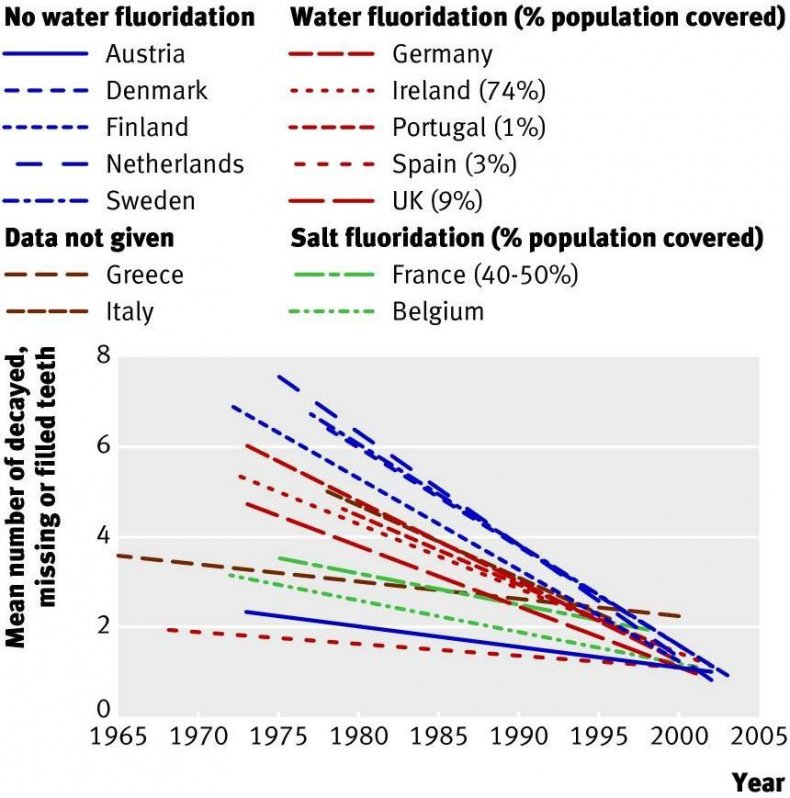Fluoride is most effective when applied topically to the surface of the teeth. Therefore, it seems unnecessary for over 3/4 of U.S. tap water to contain the chemical for consumption. Fluoride was introduced in the 1940’s as a tap water additive because it helps kill cavity-causing bacteria on people’s teeth. However, none of our body’s biological processes require fluoride to function. Fluoride is not a nutrient, it is a chemical. Check the fluoride-containing toothpaste labels – it contains a warning to contact poison control if a pea-sized amount, or more, is swallowed.
Dental fluorosis, a sign of excess fluoride exposure, shows up on teeth as white or brown stains on the enamel and is a permanent condition. Some studies showed that 30-40% of children and adolescents have this condition.
The Center for Disease Control also warn mothers of babies and toddlers about using fluoridated tap water in infant formula as there “may be an increased chance for mild dental fluorosis.”
There’s concern for adults as well; fluoride may increase underactive thyroid disorder, also known as hypothyroidism.
Recent studies have suggested a link between fluoridation and attention deficit hyperactivity disorder (ADHD). A multitude of studies, both in humans and animals, show fluoride impairs learning and memory as well as IQ scores.
Adults excrete about 60% of fluoride through their kidneys, whereas adolescents clear about 45%. For teenagers, findings from a study at Mount Sinai suggest that fluoride can be detrimental to kidney and liver function.
Fluoride’s potential negative effects include kidney and liver damage, thyroid dysfunction, bone (and tooth) disease, impaired protein metabolism, and may cause brain (and pineal gland) damage.
Look below at the chart; you’ll notice that the rates of cavities have decreased for all countries – including those that didn’t fluoridate their water.

The rates of cavities in the population have declined since fluoride was added to the water post-World War II, but what could explain this drop for countries that didn’t fluoridate theirs? Well, a variety of factors could be at play since the mid-1940s, including: access to dentists and regular dental care, better education about dental health, toothbrush and dental care technology. If Austria and northern European countries are seeing a decline in dental caries without fluoridation, is it worth the potential risks to our health to have fluoride in ours? Only you can decide.
What’s the Safe Level of Fluoride then?
Right off the bat, it’s important to know that the U.S. Food and Drug Administration (FDA) classifies fluoride as a drug when it is used to prevent or ameliorate disease. All other water treatment chemicals are added to improve water quality or safety, but fluoride is the only chemical added to water as a medical treatment (though, as you’ll see below, the FDA calls fluoride an ‘additive’). Whether you asked for it or not, whether you need it or not, you’re being medically treated every time you drink tap water (or bottled water with fluoride).
Here’s a bit of interesting information: the U.S. Department of Health and Human Services puts the recommended fluoride level (‘healthy limit’) at 0.7 ppm (Parts Per Million) whereas the EPA drinking water “maximum contaminant level” (MCL) is 4.0 mg/L (which further down the page is said to be equivalent to ppm). It’s in rather recent times that the ‘healthy limit’ was lowered to 0.7ppm from between 0.7 and 1.2 mg/L (again, mg/L being equivalent to ppm).
Even though there’s a ‘legal limit’ to set for fluoride, the water you drink, especially from the tap, may contain 5x more than what is healthy. It’s tempting to think that fluoride is regulated by the FDA and therefore has undergone the same testing that medicines do; however, it is isn’t regulated by the FDA and hasn’t been rigorously tested, because it is considered an ‘additive’ and not a medication. Consider also that most fluoridation chemicals added to tap water are by-products of chemical manufacturing (such as aluminum) and from the phosphate fertilizer industry. This is ‘industrial grade’ and not ‘pharmaceutical grade’ fluoride being allowed into tap water.
Bottom line: do your research and determine how much exposure to fluoride you are comfortable with; make decisions on your water filter treatment accordingly.
Hint: reverse osmosis is one of the best ways to filter fluoride (and other chemicals) out of your drinking water – find out more in Is Your Water Safe?
*Original article online at https://onebitewellness.wordpress.com/2021/03/08/fluoride-cavities-hypothyroidism/
